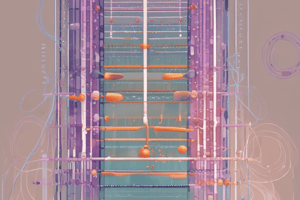Podcast
Questions and Answers
What is the primary goal of the experiments related to microbial genetics?
What is the primary goal of the experiments related to microbial genetics?
To determine the nature of the genetic material in bacterial cells.
What type of cells is used in the transformation experiment?
What type of cells is used in the transformation experiment?
Escherichia coli competent cells.
The gel electrophoresis technique separates macromolecules based on their _____ and _____ properties.
The gel electrophoresis technique separates macromolecules based on their _____ and _____ properties.
size, electric charge
Which of the following components is necessary for DNA replication?
Which of the following components is necessary for DNA replication?
Match the following models of DNA replication with their descriptions:
Match the following models of DNA replication with their descriptions:
What is the role of telomeres?
What is the role of telomeres?
DNA polymerase III has a major role in DNA replication and consists of ___ subunits.
DNA polymerase III has a major role in DNA replication and consists of ___ subunits.
What is the temperature and duration for incubating the eppendorf tubes during cell extract preparation?
What is the temperature and duration for incubating the eppendorf tubes during cell extract preparation?
Ethidium bromide allows for the visualization of nucleic acids by fluorescing under UV light.
Ethidium bromide allows for the visualization of nucleic acids by fluorescing under UV light.
Flashcards are hidden until you start studying
Study Notes
Experiment Overview
- Purpose: Investigate the nature of genetic material through enzymatic digestion and gel electrophoresis.
- Starting material: Cell-free extract from E. coli resistant to ampicillin, containing DNA, RNA, and proteins.
Preparation of Cell Extract for Transformation
- Aliquot 10 μl of cell extract into four eppendorf tubes labeled 1-4.
- Tube 1 (control): Add 10 μl sterile TE buffer.
- Tube 2: Add 10 μl DNase mix.
- Tube 3: Add 10 μl RNase.
- Tube 4: Add 10 μl protease mix.
- Incubate all tubes at 37°C for 120 minutes and then place on ice.
Gel Electrophoresis and Visualization
- Function: Separates macromolecules based on size and charge under an electric field.
- Agarose gel: Linear polysaccharide used for sieving DNA during electrophoresis.
- Gel preparation involves mixing agarose with buffer, heating, and adding ethidium bromide for visualization.
- Migration behavior: DNA fragments' migration rate is inversely proportional to their size.
Electrophoresis Procedure
- Prepare gel with 0.5x TBE buffer.
- Load samples mixed with tracking dye into wells.
- Run gels at 100 V for about 1 hour.
- Utilize UV light to visualize DNA and RNA stained with ethidium bromide.
DNA Structure and Replication Models
- Three models for DNA replication: conservative, semi-conservative, and dispersive.
- Confirmed model: semi-conservative, where each new double helix contains one parental and one new strand.
Replication in Prokaryotes and Eukaryotes
-
Prokaryotic (E. coli) replication:
- Chromosome is double-stranded and circular.
- Replication starts at origin of replication (oriC) and is bidirectional.
- Complete replication in approximately 40 minutes.
-
Eukaryotic replication:
- Chromosome is double-stranded and linear.
- Multiple origins of replication (up to 20,000 in mammalian cells).
- Challenges at telomeres during replication.
Telomeres and Telomerase
- Function: Protect the ends of chromosomes, preventing degradation.
- Shorten with age and factors such as stress and obesity.
- Telomerase maintains telomere length by adding repeats ('TTAGGG') in germline and stem cells.
DNA Polymerases and Their Functions
- Catalyze DNA synthesis in a 5’ to 3’ direction, requiring template, primer (free 3' OH), and dNTPs.
- E. coli contains five types of DNA polymerases, while eukaryotes have over 15.
- Principal enzymes: DNA polymerase III (major role) and DNA polymerase I (secondary role).
Structure of DNA Polymerase III
- Composed of ten subunits forming a holoenzyme with an asymmetric dimer structure.
- Core components:
- Alpha (α): Polymerase activity.
- Epsilon (ε): Proofreading via 3'→5' exonuclease.
- Theta (θ): Stabilizes ε and enhances proofreading.
- β clamp: A donut-shaped ring that tethers the core enzyme to DNA.
- Clamp loader: ATP-dependent mechanism for loading β clamp onto primed DNA.
- Dimer of τ subunits holds holoenzyme together and activates helicase.
Visualization Techniques
- Direct visualization of nucleic acids is not possible; intercalating agents like ethidium bromide are employed to visualize DNA under UV light.
Documentation and Analysis
- Important to document gel results with lane numbers, annotations, and detailed legends for interpretation of outcomes.
Studying That Suits You
Use AI to generate personalized quizzes and flashcards to suit your learning preferences.




